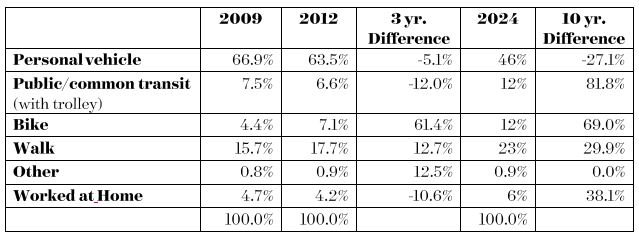CITY OF CHARLESTON
HISTORIC CHARLESTON FOUNDATION
1. Overview
A. Strategic Objectives
There are several actions which would help to maintain the character of Charleston: 1) creating more viable alternatives to driving, 2) Offering more ways for visitors to enter the historic districts by means other than the automobile, and 3) following a strategic parking plan that includes more remote parking and facilitates public transit. Sustainable growth and economic development of the Charleston Peninsula will require transportation alternatives to be developed over the next ten years. Charleston must decrease driving and parking while increasing use of public transit, cycling and walking. The high volume of visitor trips to the Peninsula should be used as a catalyst to develop transportation options which most cities this size cannot. King Street is a good example, with a high quality and variety of retailers and restaurants not typical of a city Charleston’s size.
Mode Split Goals
In keeping with these objectives, Charleston should establish goals for mobility distribution among all modes of transportation. Due to Charleston’s compact, urban downtown and walkable streets, current estimates of resident mode split are relatively impressive. Over 67% of Charleston residents have less than a 20 minute commute to work, however 63.5% drove (vs. 31.4% took public transit, walked or bikes) Nevertheless, given the constraints of Peninsular Charleston, it is necessary to achieve an extraordinary urban split among modes in order to maintain quality of life and enable economic development in the 8.45 sq miles. Below are the recommended proportions among primary trip types:
B. Background
Several of Charleston’s community leaders, including Charleston Mayor Joseph P. Riley, Jr., Tim Keane, Director of Planning, Preservation and Sustainability, and The Historic Charleston Foundation have come together to address the pressing current mobility issues, and to put together a vision for the next 10 years for The Peninsula, which is roughly 1/3 of the 128,000 population of the City of Charleston. The Peninsula is the physical and cultural center of the Charleston region, the historical center of the state, the intermodal center of the region, and the tourist draw for the Charleston area. The southern portion of the peninsula houses the College of Charleston, the historic district, the Medical University of South Carolina campus and much of the retail commerce in the area. The south side of the Peninsula has particularly narrow streets (24- 32 feet) with Meeting Street the widest at 42 feet. This limits the throughput for motor vehicle traffic as well as options for transit and bicycle facilities on-street. Pedestrian facilities are relatively robust and public space is utilized well for business and park space. The northern peninsula, particularly the eastern side, is ripe for high density, mixed-use development, and affordable housing. This is the perfect environment to encourage workers to live on the Peninsula vs. commuting, and is also a premium transit link to bridge the gap between north and south.
Advantages: Charleston, and the Peninsula in particular as the core, is seeing a renaissance, with skyrocketing housing values, booming tourism, and a robust technology incubator which began a decade ago. Additionally, the quality of life in the Peninsula in Charleston is very high with cultural venues, historic architecture that’s second to none, and a nationally renowned food and drink scene. Located on the water, it has nearby beaches, and is temperate 9 months out of the year. The walking and biking numbers are solid and attributable to the fact that the Peninsula is flat and manageable, which is a solid base to build upon. The region also benefits from SC’s Right to Work laws, major employers like BMW and Boeing to located nearby, as well as the 2 Peninsula ports and nearby airport. Mayor Riley is a nationally renowned Mayor, founder of the Mayor’s Institute on City Design (MICD), and a revered figure on the national scene known for balancing the needs of residents, tourists, business, and particularly high quality of life.
Disadvantages: The mobility options have not kept up with the growth in all areas. This is particularly apparent with the tension between residents and the growth in tourism. While many of the amenities that have made the Peninsula such a destination for both groups are due to tourism, many feel that the tourists are lowering the quality of life and are the primary cause of vehicular congestion. Ironically, there are 35,000 residents now compared to 70,000 in 1940. However in that era the streetcars still ran and the majority of people did not drive cars.
Download full version (PDF): Peninsula Mobility Report
About the City of Charleston
charleston-sc.gov
Mission: To preserve and enhance the quality of life of the citizens of the City of Charleston.
About the Historic Charleston Foundation
www.historiccharleston.org
Established in 1947, Historic Charleston Foundation is dedicated to preserving and protecting the architectural, historical and cultural character of Charleston and its Lowcountry environs, and to educating the public about Charleston’s history and the benefits that are derived from preservation.
Tags: Charleston, City of Charleston, Historic Charleston Foundation, SC, South Carolina







 RSS Feed
RSS Feed